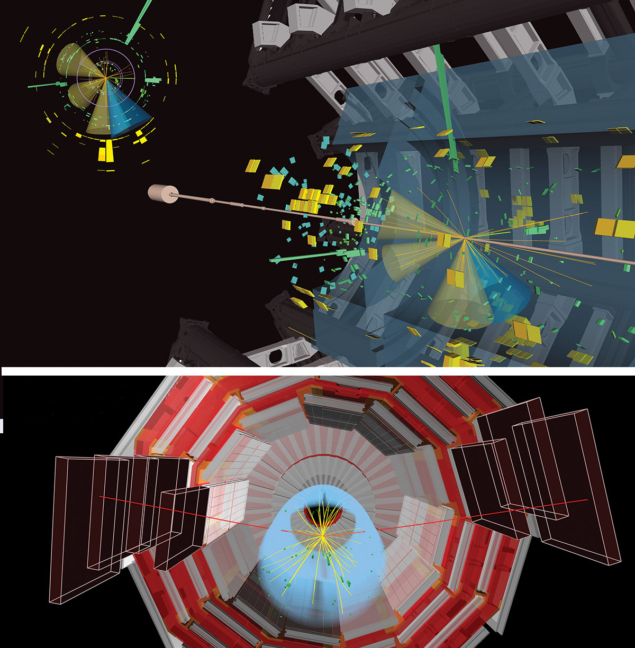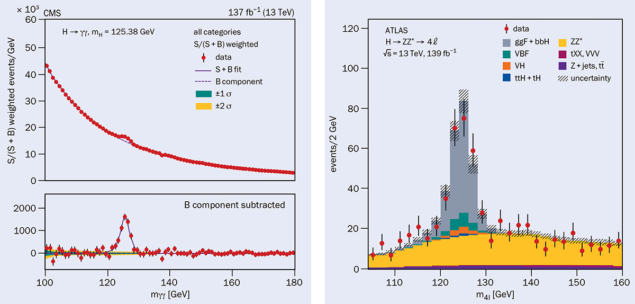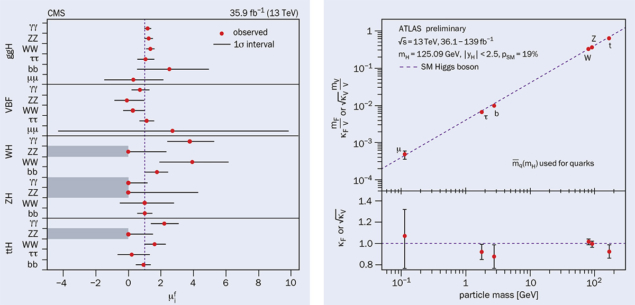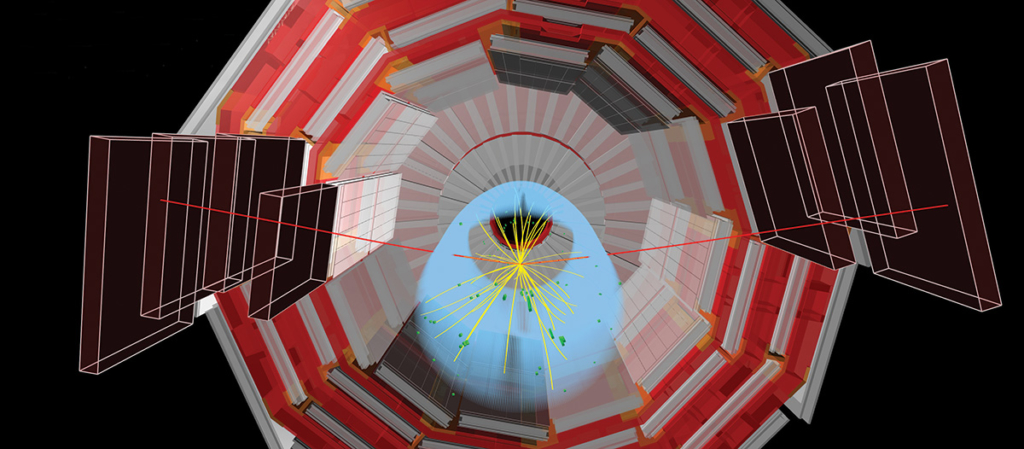Ten years of experimental scrutiny by ATLAS and CMS strongly suggest the Higgs boson originates from the minimal Higgs sector required by the Standard Model. But as Marco Pieri and Guillaume Unal explain, there is much more to learn about this unique particle.
On 4 July 2012, the ATLAS and CMS collaborations jointly announced their independent discoveries of a new particle directly related to the Brout–Englert–Higgs field that gives mass to all other particles in the Standard Model (SM). The LHC and its two general-purpose experiments were designed and built, among other things, with the aim of detecting or ruling out the SM Higgs boson. Within three years of the LHC startup, the two experiments detected a signal consistent with a Higgs boson with a mass of about 125 GeV, which was perfectly consistent with indications from precision measurements carried out at the electron–positron colliders LEP and SLC, and at the Tevatron proton–antiproton collider.

The discovery was made mainly by detecting decays of the new particle into two photons or two Z bosons (each of which decay into a pair of electrons or muons), for which the invariant mass can be reconstructed with high resolution. The search for the Higgs boson was also performed in other channels, and all results were found to be consistent with the SM expectations. A peculiar feature of the Higgs boson is that it has zero spin. At the time of the discovery, it was already excluded that the particle was a standard vector boson: a spin-1 particle cannot decay into two photons, leaving only spin-0 or spin-2 as the allowed possibilities.
Ten years ago, the vast majority of high-energy physicists were convinced that a Higgs boson had been detected. The only remaining question was whether it was the boson predicted by the SM or part of an extended Higgs sector.
Basic identity
The mass of the Higgs boson is the only parameter of the Higgs sector that is not predicted by the SM. A high-precision measurement of the mass is therefore crucial because, once it is known, all the couplings and production cross sections can be predicted in the SM and then compared with experimental measurements. The mass measurement is carried out using the H → γγ and H → ZZ → 4ℓ channels, with a combined ATLAS and CMS measurement based on Run 1 data obtaining a value of 125.09 ± 0.24 GeV. More precise results with a precision at the level of one part per thousand have been obtained by ATLAS and CMS using partial datasets from Run 2.
The width of the Higgs boson, unlike its mass, is well predicted at approximately 4 MeV. Since this is much smaller than the ATLAS and CMS detector resolutions, a precise direct measurement can only be carried out at future electron–positron colliders. At the LHC it is possible to indirectly constrain the width by studying the production of di-boson pairs (ZZ or WW) via the exchange of off-shell Higgs bosons: under some reasonable assumptions, the off-shell cross section at high mass relative to the on-shell cross section increases proportionally to the width. A recent result from CMS constrains the Higgs-boson width to be between 0.0061 and 2.0 times the SM prediction at 95% confidence level. Finding the width to be smaller than the SM would mean that some of the couplings are smaller than predicted, while a larger measured width could reflect additional decay channels beyond the SM, or a larger branching fraction of those predicted by the SM.
This is the first strong suggestion that the Higgs boson also couples to fermions from generations other than the third
The spin and charge-parity (CP) properties of the Higgs boson are other key quantities. The SM predicts that the Higgs boson is a scalar (spin-0 and positive CP) particle, but in extended Higgs models it could be a superposition of positive and negative CP states, for example. The spin and CP properties can be probed using angular distributions of the Higgs-boson decay products, and several decay channels were exploited by ATLAS and CMS: H → γγ, ZZ, WW and ττ. All results to date indicate consistency with the SM and exclude most other models at more than 3σ confidence level, including all models with spin different from zero.
Couplings to others
One of the main tools for characterising the Higgs boson is the measurement of its production processes and decays. Thanks to growing datasets, improved analysis techniques, more accurate theoretical tools and better modeling of background processes, ATLAS and CMS have made remarkable progress in this crucial programme over the past decade.
Using Run 1 data recorded between 2010 and 2012, the gluon-fusion and vector-boson fusion production processes were established, as were the decays to pairs of bosons (γγ, WW* and ZZ*) and to a τ-lepton pair from the combination of ATLAS and CMS data. With Run 2 data (2015–2018), both ATLAS and CMS observed the decay to a pair of b quarks. Although the preferred decay mode of the Higgs boson, this channel suffers from larger backgrounds and is mainly accessible in the associated production of the Higgs boson with a vector boson. The rarer production mode of the Higgs boson in association with a t-quark pair was also observed using a combination of different decay modes, providing a direct proof of the Yukawa coupling between the Higgs boson and top quark. The existence of the Yukawa couplings between the Higgs boson and third-generation fermions (t, b, τ) is thus established.

The collaborations also investigated the coupling of the Higgs boson to the second-generation fermions, in particular the muon. With the full Run 2 dataset, CMS reported evidence at the level of 3σ over the background-only hypothesis that the Higgs boson decays into μ+μ–, while ATLAS supported this finding with a 2σ excess. This is the first strong suggestion that the Higgs boson also couples to fermions from generations other than the third, again in accordance with the SM. Research is also ongoing to constrain the Higgs’s coupling to charm quarks via the decay H → cc. This is a much more difficult channel but, thanks to improved detectors and analysis methods, including extensive use of machine learning, ATLAS and CMS recently achieved a sensitivity beyond expectations and excluded a branching fraction of H → cc relative to the SM prediction larger than O(10). The possibility that the Higgs-boson’s coupling to charm is at least as large as the coupling to bottom quarks is excluded by a recent ATLAS analysis at 95% confidence level.
The accuracy of the production cross-section times decay branching-fraction measurements in the bosonic decay channel (diphoton, ZZ and WW) with the full Run 2 dataset is around 10%, allowing measurements in a more restricted kinematical region that can be sensitive to physics beyond the SM. In all probed phase-space regions, the measured cross sections are compatible with the SM expectations (Data used for some of the measurements are shown in the “Mass spectra” figure).
Ten years after the discovery of a new elementary boson, considerable progress has been made toward understanding this particle
The combination of all measurements in the different production and decay processes can be used to further constrain the measured couplings between the Higgs boson and the other particles. The production cross section for vector-boson-fusion production, for example, is directly proportional to the square of the coupling strengths between the Higgs boson and W or Z bosons. A modification of these couplings will also affect the rate at which the Higgs boson decays to various final states. Assuming no contribution beyond the SM to Higgs decays and that only SM particles contribute to Higgs-boson vertices involving loops, couplings to t, b and τ are currently determined with uncertainties of around 10%, and couplings to W and Z bosons with uncertainties of about 5%.
The relation between the mass of a particle and its coupling to the Higgs boson is as expected from the SM, in which the particle masses originate from their coupling to the Brout–Englert–Higgs field (see “Couplings” figure). These measurements thus set bounds on specific new-physics models that predict deviations of the Higgs-boson couplings from the SM. The impact of new physics at a high energy scale is also probed in effective-field-theory frameworks, introducing all possible operators that describe couplings of the Higgs boson to SM particles. No deviations from predictions are observed.
New physics
The Higgs boson is the only elementary particle with spin-0. However, an extended Higgs sector is a minimal extension of the SM and is predicted by many theories, such as those based on supersymmetry. These extensions predict several neutral or charged spin-0 particles: one is the observed 125 GeV Higgs boson; the others would preferentially couple to heavier SM particles. Searches for heavier scalar (or pseudo-scalar) particles have been carried out in a variety of final states, but no evidence for such particles is found. For example, the search for heavy scalar or pseudo-scalar particles decaying to a pair of τ leptons excludes masses up to 1–1.5 TeV. The extended Higgs sector can also include lighter scalar or pseudo-scalar particles into which the observed Higgs boson could decay. A wide range of final states have been investigated but no evidence found, setting stringent constraints on the corresponding Higgs-boson decay branching fractions.

The Higgs sector could also play a role linking the SM to new physics that explains the presence of dark matter in the form of new neutral, weakly interacting particles. If their mass is less than half that of the Higgs boson, the Higgs boson could decay to a pair of these neutral particles. Since the particles would be invisible in the detector, this process can be detected by observing the presence of missing transverse momentum from the Higgs-boson recoiling against visible particles. The most sensitive processes are those in which the Higgs boson is produced in association to other particles: vector boson fusion, and the associated productions with a vector boson or with a top quark pair. No evidence of such decay has been found, setting upper limits on the invisible decay branching fraction of the Higgs boson at the level of 10%, and providing complementary constraints to those from direct dark-matter detection experiments.
Self-interaction
In addition to its couplings to other bosons and to fermions, the structure of the Brout–Englert–Higgs potential predicts a self-coupling of the Higgs boson that is related to electroweak symmetry breaking (see Electroweak baryogenesis). By studying Higgs-boson pair production at the LHC, it is possible to directly probe this self-coupling.
The two main challenges of this measurement are the tiny cross section for Higgs-boson pair production (about 1000 times smaller than the production of a single Higgs boson) and the interference between processes that involve the self-coupling and those that do not. Final states with a favourable combination of the expected signal yield and signal-over-background ratio are exploited. The most sensitive channels are those with one Higgs boson decaying to a b-quark pair and the other decaying either to a pair of photons, τ leptons or b quarks. Upper limits of approximately three times the predicted cross section have been obtained with the Run 2 dataset. These searches can also be used to set constraints on the Higgs boson self-coupling relative to its SM value.
The sensitivities achieved for Higgs-boson pair production searches with the Run 2 dataset are significantly better than expected before the start of Run 2, thanks to several improvements in object reconstruction and analysis techniques. These searches are mostly limited by the size of the dataset and thus will improve further with the Run 3 and much larger High-Luminosity LHC (HL-LHC) datasets.
Going further
Ten years after the discovery of a new elementary boson, considerable progress has been made toward understanding this particle. All measurements so far point to properties that are very consistent with the SM Higgs boson. All main production and decay modes have been observed by ATLAS and CMS, and the couplings to vector bosons and third-generation fermions are probed with 5 to 10% accuracy, confirming the pattern expected from the Brout–Englert–Higgs mechanism for electroweak symmetry breaking and the generation of the masses of elementary particles. Still, there is ample room for improvement in the forthcoming Run 3 and HL-LHC phases, to reduce the uncertainty in the coupling measurements down to a few per cent, to establish couplings to second-generation fermions (muons) and to investigate the Higgs-boson self-coupling. Improved measurements will also significantly expand the sensitivity to a possible extended Higgs sector or new dark sector.
To reach the ultimate accuracy in the measurements of all Higgs-boson properties (including its self-coupling), to remove the assumptions in the determination of the Higgs couplings at the LHC, and to considerably extend the search for new physics in the Higgs sector, new colliders – such as an e+e– collider and a future hadron collider – will be required.






